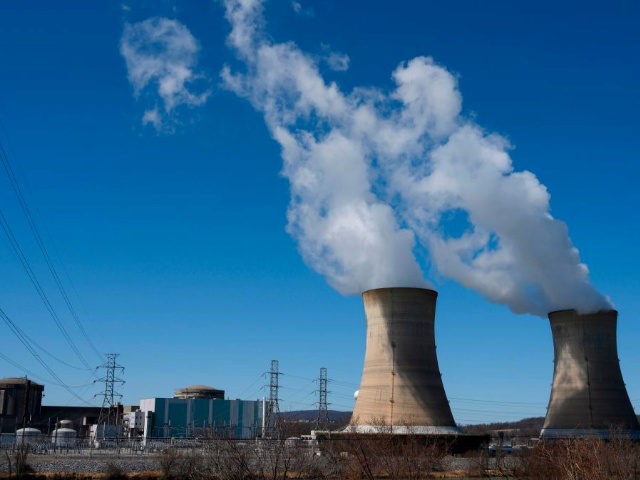A Gallup poll shows that Democrats — many of whom believe climate change will end civilization in 12 years — oppose nuclear power despite the fact that it is a clean energy resource with an overall good safety record.
The polling organization took the survey on the 40th anniversary of the Three Mile Island (TMI) nuclear plant accident where a partial meltdown of the core took place and trace amounts of radiation were released, although no ill health consequences in people living in the area were documented.
Nonetheless, Americans are evenly split on their support for nuclear power — 49 percent for and 49 percent against — and only 47 percent of respondents believe that nuclear power plants are safe.
And only 42 percent of Democrats expressed support for nuclear power while 65 percent of Republicans support it.
Gallup reported:
These results come from Gallup’s annual Environment poll, conducted March 1-10. The poll preceded the 40th anniversary of the March 28, 1979, TMI accident. That accident effectively halted the expansion of nuclear power in the U.S., with no new plants constructed for 30 years after the partial meltdown at TMI. Now, many of the country’s existing nuclear power stations are potentially approaching the end of their service lives and the industry faces pressure from organized opposition to the use of nuclear power as well as competition from cheaper energy alternatives such as natural gas.
The current 49 percent of Americans who support nuclear power in the U.S. is a modest five percentage points higher than the 44 percent who said the same the last time Gallup asked about this issue in 2016. However, it is well below the record-high 62 percent who favored nuclear power in 2010. That high point came amid surging oil prices in the U.S. that made nuclear power a welcome alternative. Since then, increased production of domestic oil and natural gas has driven energy costs lower and Americans’ support for nuclear power has subsequently trended downward — perhaps causing the public to consider whether the risks of using nuclear power outweigh its benefits.
Gallup noted that a poll about nuclear power before TMI in 1976 showed 42 percent in support of the industry, and that support plummeted to just 23 percent in 1986 — the year of the Chernobyl nuclear power plant meltdown in the Ukraine, where 30 people died from radiation poisoning.
People are also divided on nuclear power along education and gender lines.
“Support for the use of nuclear power is higher among those with more formal education,” Gallup reported. “Sixty percent of college graduates favor its use, compared with 51 percent of those with some college education and 37 percent of those with no college education.”
More men — 56 percent — than women — 39 percent — are supportive of nuclear power.
The safety issue is the one that is record-setting in this poll as it is the first time that 49 percent of respondents said they do not believe nuclear power plants are safe, compared with 47 percent who think they are safe.
“Even in the 2011 poll, conducted two weeks after the high-profile Fukushima Daiichi nuclear accident in Japan, a majority said they viewed nuclear power plants as safe,” Gallup reported.
Gallup noted that, aside from safety, Americans’ view of nuclear power is tied to energy costs and even its reputation as a clean energy source. Gallup noted 60 percent of Americans favor reducing the use of fossil fuels.
According to the Nuclear Energy Institute, nuclear power “continues to be recognized as one of the safest industrial working environments in the nation.”
The industry faces national and international scrutiny of its plant operations and requires operators to be federally licensed.
Nuclear power plants also have “multiple physical barriers that protect against accidental radiation release,” such as the rods that encase the uranium fuel used to power nuclear plants, the reactor that contains the rods, and the steel-reinforced concrete building that houses the reactor.
According to the U.S. Energy Information Administration (EIA):
There are 60 commercially operating nuclear power plants with 98 nuclear reactors in 30 U.S. states (the Indian Point Energy Center in New York has two nuclear reactors that the U.S. Energy Information Administration counts as two separate nuclear plants). Of these nuclear plants, 36 have two or more reactors. The Palo Verde nuclear power plant in Arizona is the largest nuclear plant, and it has three reactors with a combined net summer electricity generating capacity of 3,937 megawatts (MW). The R. E. Ginna Nuclear Power Plant in New York is the smallest nuclear plant, and it has one reactor with a net summer electricity generating capacity of 508 MW.
The newest nuclear reactor to enter service, Watts Bar Unit 2 with 1,150 MW net summer electricity generating capacity, began commercial operation in October 2016.
Two new nuclear reactors are actively under construction: Vogtle Units 3 and 4 in Georgia.
The Gallup poll results are based on telephone interviews conducted March 1–10, 2019, with a random sample of 1,039 adults, aged 18 or older, in all 50 U.S. states and the District of Columbia. The margin of error is plus or minus five percentage points, with a 95 percent confidence level.
Results for the support for nuclear energy question are from a random sample of 538 adults with a margin of sampling error of plus or minus five percentage points, with a 95 percent confidence level.
Results for the safety of nuclear power plants question are from a random sample of 501 adults with a margin of sampling error of plus or minus five percentage points, with a 95 percent confidence level.
Follow Penny Starr on Twitter.

COMMENTS
Please let us know if you're having issues with commenting.